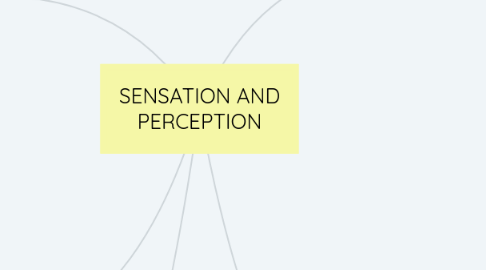
1. THE AUDITORY SYSTEM
1.1. The Nature of Sound and How We Experience It
1.2. Structure and Functions of The Ear
1.2.1. Outer Ear
1.2.2. Middle Ear
1.2.3. Inner Ear
1.3. Theories of Hearing
1.3.1. Place Theory
1.3.2. Frequency Theory
1.3.3. Volley Principle
1.4. Auditory Processing In The Brain
1.4.1. Auditory Nerve
1.5. Localizing Sound
2. OTHER SENSES
2.1. The Skin Senses
2.1.1. Touch
2.1.2. Temperature
2.1.2.1. Thermoreceptors
2.1.3. Pain
2.2. The Chemical Senses
2.2.1. Taste
2.2.1.1. Papillae
2.2.2. Smell
2.2.2.1. Olfactory Epithelium
2.3. The Kinesthetic and Vestibular Senses
2.3.1. Kinesthetic Senses
2.3.2. Vestibular Senses
2.3.3. Semicircular Canals
3. SENSATION, PERCEPTION, AND HEALTH AND WELLNESS
4. HOW WE SENSE AND PERCEIVE THE WORLD
4.1. The Processes and Purpose of Sensation and Perception
4.1.1. Sensation
4.1.2. Perception
4.1.3. Bottom-Up and Top-Down Processing
4.1.3.1. Bottom-Up Processing
4.1.3.2. Top-Down Processing
4.1.4. The Purpose of Sensation and Perception
4.2. Sensory Receptors and The Brain
4.2.1. Sensory Receptors
4.3. Thresholds
4.3.1. Absolute Threshold
4.3.1.1. Noise
4.3.2. Difference Threshold
4.3.2.1. Weber's Law
4.3.3. Subliminal Perception
4.4. Signal Detection Theory
4.5. Perceiving Sensory Stimuli
4.5.1. Attention
4.5.1.1. Selective Attention
4.5.2. Perceptual Set
4.6. Sensory Adaptation
5. THE VISUAL SYSTEM
5.1. The Visual Stimulus and The Eye
5.1.1. Light
5.1.2. The Structure of The Eye
5.1.2.1. Retina
5.1.2.2. Rods
5.1.2.3. Cones
5.1.2.4. Optic Nerve
5.2. Visual Processing In The Brain
5.2.1. The Visual Cortex
5.2.1.1. Feature Detectors
5.2.2. Parallel Processing
5.2.3. Binding
5.3. Color Vision
5.3.1. Trichromatic Theory
5.3.2. Opponent-Process Theory
5.4. Perceiving Shape, Depth, Motion, and Consistancy
5.4.1. Shape
5.4.1.1. Figure-Ground Relationship
5.4.1.2. Gestalt Psychology
5.4.2. Depth Perception
5.4.2.1. Binocular Cues
5.4.2.2. Convergence
5.4.2.3. Monocular Cues
5.4.3. Motion Perception
5.4.3.1. Apparent Movement
5.4.4. Perceptual Constancy
